Design of Compact Planar Monopole UWB MIMO Antenna with Four Orthogonal Elements and Tapered Fed Configuration for Wireless Diversity Applications
Abstract
:1. Introduction
- The UWB range, as well as other allocated communications ranges, are occupied by a single antenna port with the introduction of the diversity for efficient use of these bands.
- Using orthogonal radiators to achieve high separation without employing any complicated structure for decoupling.
- The compact size of the whole antenna design for the frequency band extending from 3.1 to 10.6 GHz. The size of the MIMO antenna is small enough to be packaged in a square case, making it useful for portable devices.
2. Proposed Antenna Design
2.1. Unit Cell Design
2.2. Monopole UWB MIMO Antenna
3. Results and Discussion
3.1. Mutual Coupling
3.2. Envelope Correlation Coefficient (ECC)
3.3. Diversity Gain (DG)
3.4. Total Active Reflection Coefficient (TARC)
3.5. Mean Effective Gain (MEG)
3.6. Channel Capacity Loss (CCL)
3.7. Gain and Percentage Efficiency
3.8. Radiation Patterns
4. Conclusions
Author Contributions
Funding
Data Availability Statement
Conflicts of Interest
References
- Chen, Z.N.; Ammann, M.J.; Qing, X.; Wu, X.H.; See, T.S.; Cai, A. Planar antennas. IEEE Microw. Mag. 2006, 7, 63–73. [Google Scholar] [CrossRef]
- Zhou, G.; Deng, R.; Zhou, X.; Long, S.; Li, W.; Lin, G.; Li, X. Gaussian Inflection Point Selection for LiDAR Hidden Echo Signal Decomposition. IEEE Geosci. Remote Sens. Lett. 2021, 19, 1–5. [Google Scholar] [CrossRef]
- Kong, H.; Lu, L.; Yu, J.; Chen, Y.; Tang, F. Continuous Authentication Through Finger Gesture Interaction for Smart Homes Using WiFi. IEEE Trans. Mob. Comput. 2021, 20, 3148–3162. [Google Scholar] [CrossRef]
- Liu, G. Data Collection in MI-Assisted Wireless Powered Underground Sensor Networks: Directions, Recent Advances, and Challenges. IEEE Commun. Mag. 2021, 59, 132–138. [Google Scholar] [CrossRef]
- Schantz, H.G. A brief history of UWB antennas. IEEE Aerosp. Electron. Syst. Mag. 2004, 19, 22–26. [Google Scholar] [CrossRef]
- Zhou, G.; Li, W.; Zhou, X.; Tan, Y.; Lin, G.; Li, X.; Deng, R. An innovative echo detection system with STM32 gated and PMT adjustable gain for airborne LiDAR. Int. J. Remote Sens. 2021, 42, 9187–9211. [Google Scholar] [CrossRef]
- Zhou, G.; Long, S.; Xu, J.; Zhou, X.; Song, B.; Deng, R.; Wang, C. Comparison Analysis of Five Waveform Decomposition Algorithms for the Airborne LiDAR Echo Signal. IEEE J. Sel. Top. Appl. Earth Obs. Remote Sens. 2021, 14, 7869–7880. [Google Scholar] [CrossRef]
- Wu, H.; Jin, S.; Yue, W. Pricing Policy for a Dynamic Spectrum Allocation Scheme with Batch Requests and Impatient Packets in Cognitive Radio Networks. J. Syst. Sci. Syst. Eng. 2022, 31, 133–149. [Google Scholar] [CrossRef]
- Federal Communications Commission, Revision of Part 15 of the Commission’s Rules Regarding Ultra-Wideband Transmission Systems. First Report and Order, pp.FCC-02. Available online: https://www.fcc.gov/document/revision-part-15-commissions-rules-regarding-ultra-wideband-7 (accessed on 1 August 2022).
- Khan, M.S.; Capobianco, A.-D.; Asif, S.M.; Anagnostou, D.E.; Shubair, R.M.; Braaten, B.D. A Compact CSRR-Enabled UWB Diversity Antenna. IEEE Antennas Wirel. Propag. Lett. 2016, 16, 808–812. [Google Scholar] [CrossRef]
- Chandel, R.; Gautam, A.K.; Rambabu, K. Design and Packaging of an Eye-Shaped Multiple-Input–Multiple-Output Antenna with High Isolation for Wireless UWB Applications. IEEE Trans. Compon. Packag. Manuf. Technol. 2018, 8, 635–642. [Google Scholar] [CrossRef]
- Saxena, S.; Kanaujia, B.; Dwari, S.; Kumar, S.; Tiwari, R. MIMO antenna with built-in circular shaped isolator for sub-6 GHz 5G applications. Electron. Lett. 2018, 54, 478–480. [Google Scholar] [CrossRef]
- Dikmen, C.M.; Cimen, S.; Cakir, G. Planar Octagonal-Shaped UWB Antenna with Reduced Radar Cross Section. IEEE Trans. Antennas Propag. 2014, 62, 2946–2953. [Google Scholar] [CrossRef]
- Gopikrishna, M.; Das Krishna, D.; Anandan, C.K.; Mohanan, P.; Vasudevan, K. Design of a Compact Semi-Elliptic Monopole Slot Antenna for UWB Systems. IEEE Trans. Antennas Propag. 2009, 57, 1834–1837. [Google Scholar] [CrossRef]
- Saad, A.A.R.; Mohamed, H.A. Conceptual design of a compact four-element UWB MIMO slot antenna array. IET Microw. Antennas Propag. 2019, 13, 208–215. [Google Scholar] [CrossRef]
- Tang, Z.; Wu, X.; Zhan, J.; Hu, S.; Xi, Z.; Liu, Y. Compact UWB-MIMO Antenna With High Isolation and Triple Band-Notched Characteristics. IEEE Access 2019, 7, 19856–19865. [Google Scholar] [CrossRef]
- Yang, L.; Xu, M.; Li, C. Four-Element MIMO Antenna System for UWB Applications. Radioengineering 2019, 28, 60–67. [Google Scholar] [CrossRef]
- Koohestani, M.; Moreira, A.A.; Skrivervik, A.K. A Novel Compact CPW-Fed Polarization Diversity Ultrawideband Antenna. IEEE Antennas Wirel. Propag. Lett. 2014, 13, 563–566. [Google Scholar] [CrossRef]
- Yu, J.-F.; Liu, X.L.; Shi, X.-W.; Wang, Z. A compact four-element UWB MIMO antenna with QSCA implementation. Prog. Electromagn. Res. Lett. 2014, 50, 103–109. [Google Scholar] [CrossRef]
- Wang, L.; Du, Z.; Yang, H.; Ma, R.; Zhao, Y.; Cui, X.; Xi, X. Compact UWB MIMO Antenna with High Isolation Using Fence-Type Decoupling Structure. IEEE Antennas Wirel. Propag. Lett. 2019, 18, 1641–1645. [Google Scholar] [CrossRef]
- Wang, F.; Duan, Z.; Li, S.; Wang, Z.L.; Gong, Y.B. Compact UWB MIMO antenna with metamaterial-inspired isolator. Prog. Electromagn. Res. C 2018, 84, 61–74. [Google Scholar]
- Srivastava, G.; Dwari, S.; Kanuijia, B.K. A compact 4 × 4 ultrawideband(UWB) band notched MIMO antenna. In Proceedings of the 2014 IEEE International Microwave and RF Conference (IMaRC), Bangalore, India, 15–17 December 2014; IEEE: Piscataway, NJ, USA, 2014; pp. 198–200. [Google Scholar] [CrossRef]
- Mao, C.-X.; Chu, Q.-X. Compact Coradiator UWB-MIMO Antenna with Dual Polarization. IEEE Trans. Antennas Propag. 2014, 62, 4474–4480. [Google Scholar] [CrossRef]
- Zhu, J.; Li, S.; Feng, B.; Deng, L.; Yin, S. Compact dual-polarized UWB quasi-self-complementary MIMO/diversity antenna with band-rejection capability. IEEE Antennas Wirel. Propag. Lett. 2015, 15, 905–908. [Google Scholar] [CrossRef]
- Wu, Y.; Ding, K.; Zhang, B.; Li, J.; Wu, D.; Wang, K. Design of a Compact UWB MIMO Antenna without Decoupling Structure. Int. J. Antennas Propag. 2018, 2018, 9685029. [Google Scholar] [CrossRef]
- Behdad, N.; Li, M.; Yusuf, Y. A Very Low-Profile, Omnidirectional, Ultrawideband Antenna. IEEE Antennas Wirel. Propag. Lett. 2013, 12, 280–283. [Google Scholar] [CrossRef]
- Altaf, A.; Iqbal, A.; Smida, A.; Smida, J.; Althuwayb, A.A.; Hassan Kiani, S.; Alibakhshikenari, M.; Falcone, F.; Limiti, E. Iso-lation Improvement in UWB-MIMO Antenna System Using Slotted Stub. Electronics 2020, 9, 1582. [Google Scholar] [CrossRef]
- Liu, X.-L.; Wang, Z.-D.; Yin, Y.-Z.; Ren, J.; Wu, J.-J. A Compact Ultrawideband MIMO Antenna Using QSCA for High Isolation. IEEE Antennas Wirel. Propag. Lett. 2014, 13, 1497–1500. [Google Scholar] [CrossRef]
- Tripathi, S.; Mohan, A.; Yadav, S. A Compact Koch Fractal UWB MIMO Antenna With WLAN Band-Rejection. IEEE Antennas Wirel. Propag. Lett. 2015, 14, 1565–1568. [Google Scholar] [CrossRef]
- Althuwayb, A.A. Low-Interacted Multiple Antenna Systems Based on Metasurface-Inspired Isolation Approach for MIMO Applications. Arab. J. Sci. Eng. 2022, 47, 2629–2638. [Google Scholar] [CrossRef]
- Alibakhshikenari, M.; Babaeian, F.; Virdee, B.S.; Aïssa, S.; Azpilicueta, L.; See, C.H.; Althuwayb, A.A.; Huynen, I.; Abd-Alhameed, R.A.; Falcone, F.; et al. A comprehensive survey on “Various decoupling mechanisms with fo-cus on metamaterial and metasurface principles applicable to SAR and MIMO antenna systems”. IEEE Access 2020, 8, 192965–193004. [Google Scholar] [CrossRef]
- Althuwayb, A.A. Enhanced radiation gain and efficiency of a metamaterial-inspired wideband microstrip antenna using substrate integrated waveguide technology for sub-6 GHz wireless communication systems. Microw. Opt. Technol. Lett. 2021, 63, 1892–1898. [Google Scholar] [CrossRef]
- Alibakhshikenari, M.; Virdee, B.S.; Salekzamankhani, S.; Aïssa, S.; See, C.H.; Soin, N.; Fishlock, S.J.; Althuwayb, A.A.; Abd-Alhameed, R.; Huynen, I.; et al. High-isolation antenna array using SIW and realized with a graphene layer for sub-terahertz wireless applications. Sci. Rep. 2021, 11, 10218. [Google Scholar] [CrossRef] [PubMed]
- Jamshed, M.A.; Ur-Rehman, M.; Frnda, J.; Althuwayb, A.A.; Nauman, A.; Cengiz, K. Dual Band and Dual Diversity Four-Element MIMO Dipole for 5G Handsets. Sensors 2021, 21, 767. [Google Scholar] [CrossRef] [PubMed]
- Naktong, W.; Ruengwaree, A. Four-port rectangular monopole antenna for UWB-MIMO applications. Prog. Electromagn. Res. B 2020, 87, 19–38. [Google Scholar] [CrossRef]
- CST Microwave Studio Suite 2018. Available online: www.cst.com (accessed on 1 August 2022).
- Khalid, M.; Naqvi, S.I.; Hussain, N.; Rahman, M.; Fawad; Mirjavadi, S.S.; Khan, M.J.; Amin, Y. 4-Port MIMO Antenna with Defected Ground Structure for 5G Millimeter Wave Applications. Electronics 2020, 9, 71. [Google Scholar] [CrossRef]
- Chae, S.H.; Kawk, W.I.; Park, S.-O.; Lee, K. Analysis of mutual coupling in MIMO antenna array by TARC calculation. In Proceedings of the 2006 Asia-Pacific Microwave Conference, Yokohama, Japan, 12–15 December 2006; IEEE: Piscataway, NJ, USA, 2006; pp. 2090–2093. [Google Scholar] [CrossRef]
- Chae, S.H.; Oh, S.-K.; Park, S.-O. Analysis of Mutual Coupling, Correlations, and TARC in WiBro MIMO Array Antenna. IEEE Antennas Wirel. Propag. Lett. 2007, 6, 122–125. [Google Scholar] [CrossRef]
- Amin, F.; Saleem, R.; Shabbir, T.; Rehman, S.U.; Bilal, M.; Shafique, M.F. A Compact Quad-Element UWB-MIMO Antenna System with Parasitic Decoupling Mechanism. Appl. Sci. 2019, 9, 2371. [Google Scholar] [CrossRef]
- Anitha, R.; Vinesh, P.V.; Prakash, K.C.; Mohanan, P.; Vasudevan, K. A Compact Quad Element Slotted Ground Wideband Antenna for MIMO Applications. IEEE Trans. Antennas Propag. 2016, 64, 4550–4553. [Google Scholar] [CrossRef]
- Taga, T. Analysis for mean effective gain of mobile antennas in land mobile radio environments. IEEE Trans. Veh. Technol. 1990, 39, 117–131. [Google Scholar] [CrossRef]
- Nasir, J.; Jamaluddin, M.H.; Khan, A.A.; Kamarudin, M.R.; Leow, C.Y.; Owais, O. Throughput Measurement of a Dual-Band MIMO Rectangular Dielectric Resonator Antenna for LTE Applications. Sensors 2017, 17, 148. [Google Scholar] [CrossRef] [Green Version]
- Ali, W.A.; Ibrahim, A.A. A compact double-sided MIMO antenna with an improved isolation for UWB applications. AEU Int. J. Electron. Commun. 2017, 82, 7–13. [Google Scholar] [CrossRef]
- Ibrahim, A.A.; Abdalla, M.A.; Hu, Z. Design of a compact mimo antenna with asymmetric coplanar strip-fed for UWB applications. Microw. Opt. Technol. Lett. 2017, 59, 31–36. [Google Scholar] [CrossRef]
- Malviya, L.; Panigrahi, R.K.; Kartikeyan, M.V. Four Element Planar MIMO Antenna Design for Long-Term Evolution Operation. IETE J. Res. 2018, 64, 367–373. [Google Scholar] [CrossRef]
- Kolangiammal, S.; Vairavel, G. Compact Planar Monopole UWB MIMO Antenna for Diversity Applications. In Advances in Smart System Technologies; Springer: Singapore, 2021; pp. 281–291. [Google Scholar] [CrossRef]
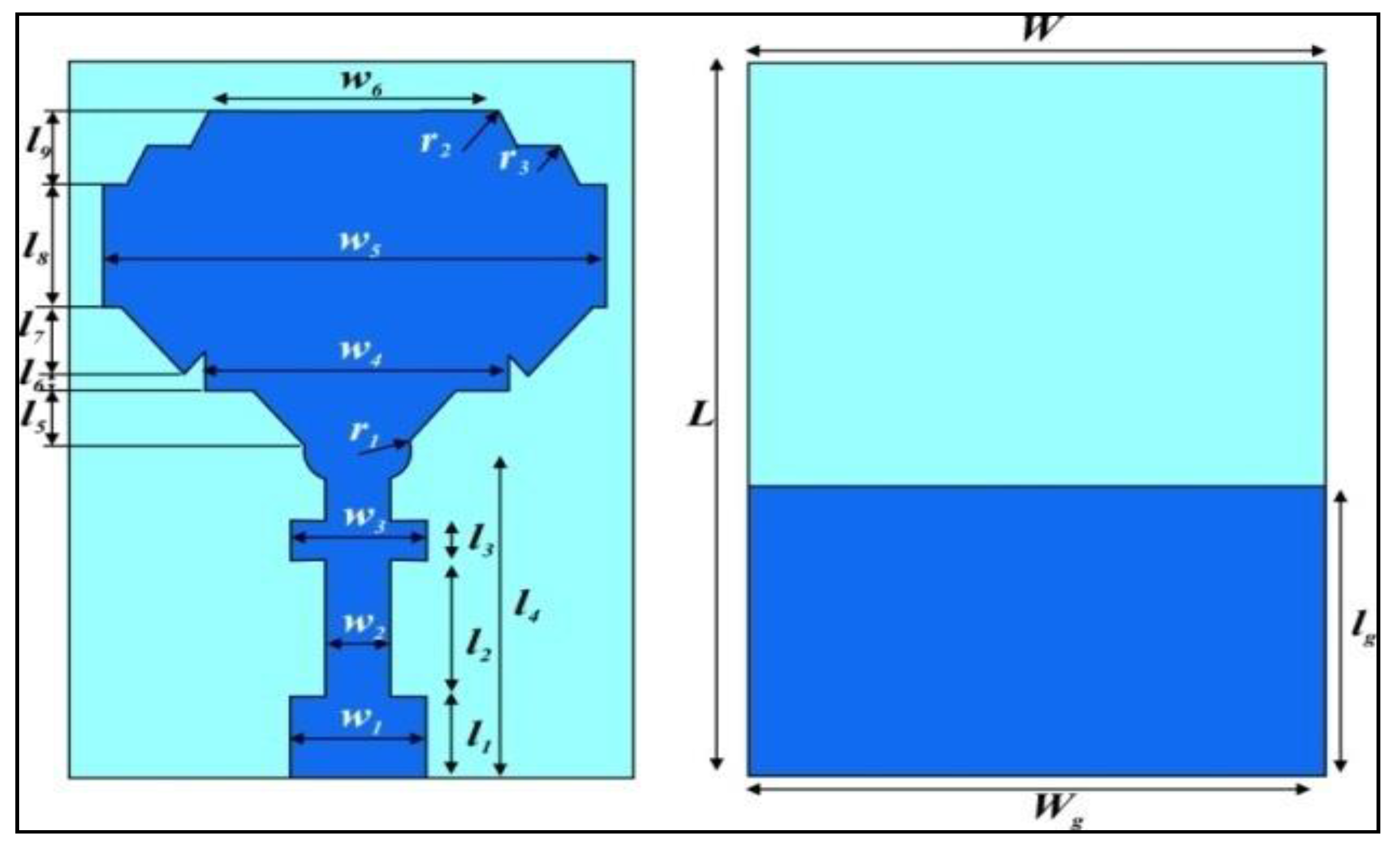

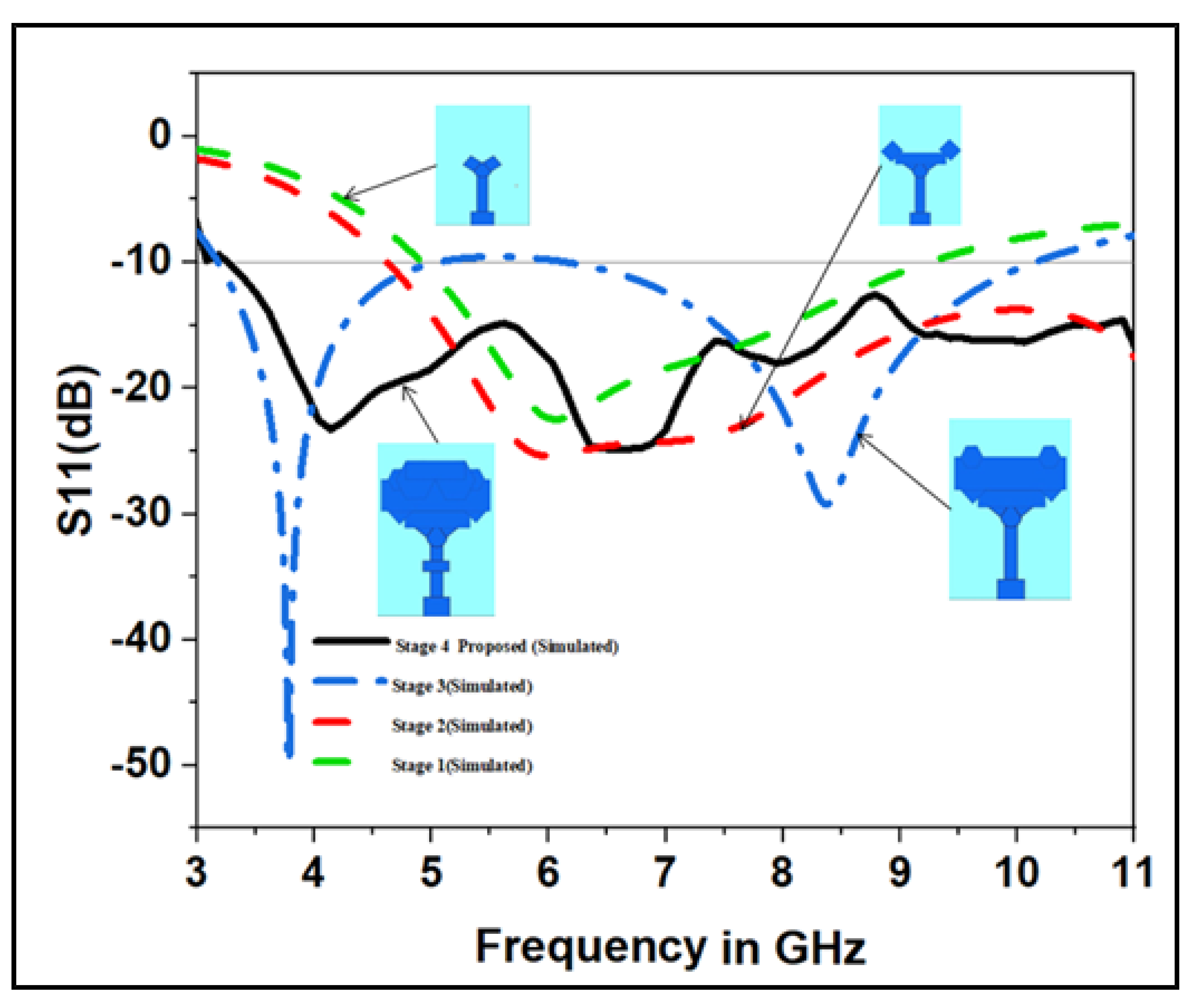
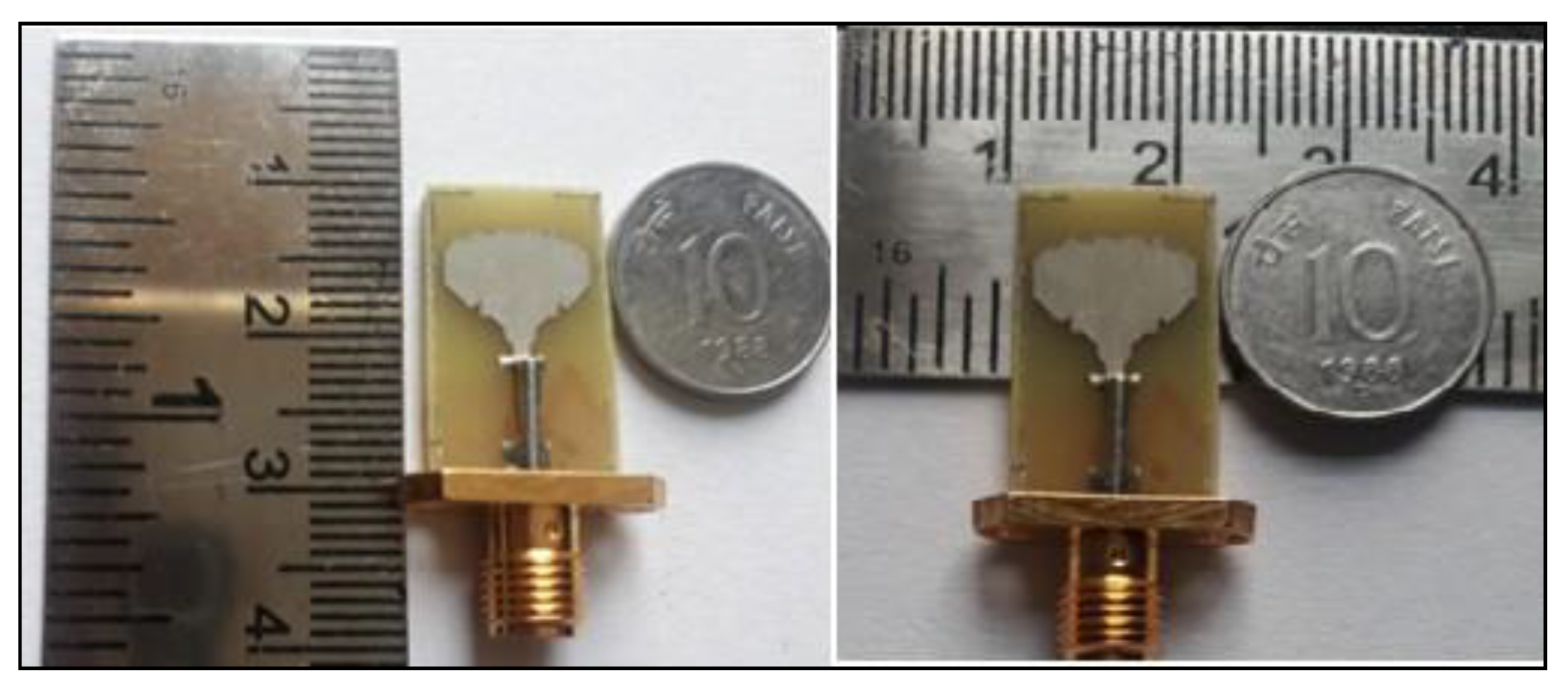


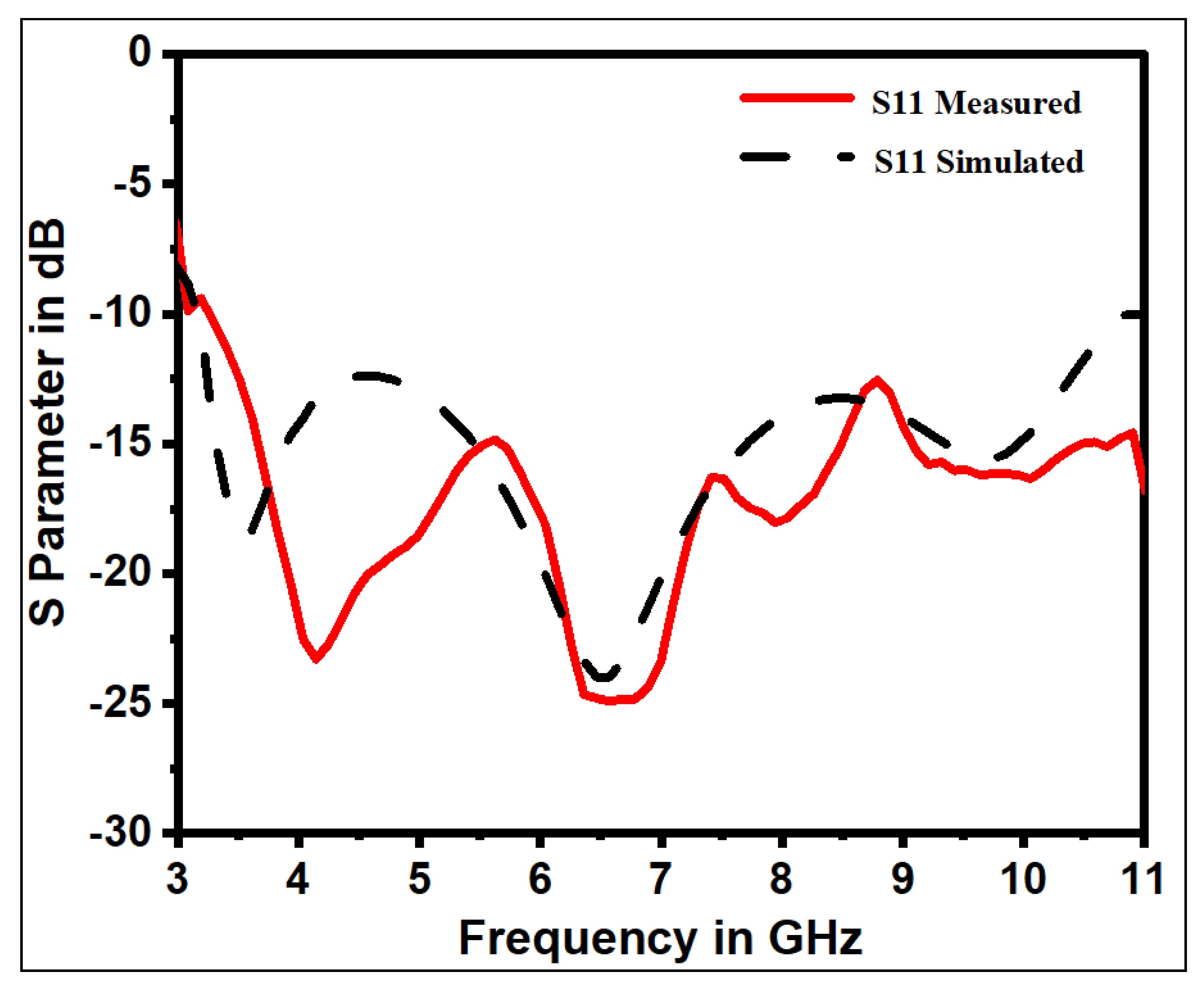
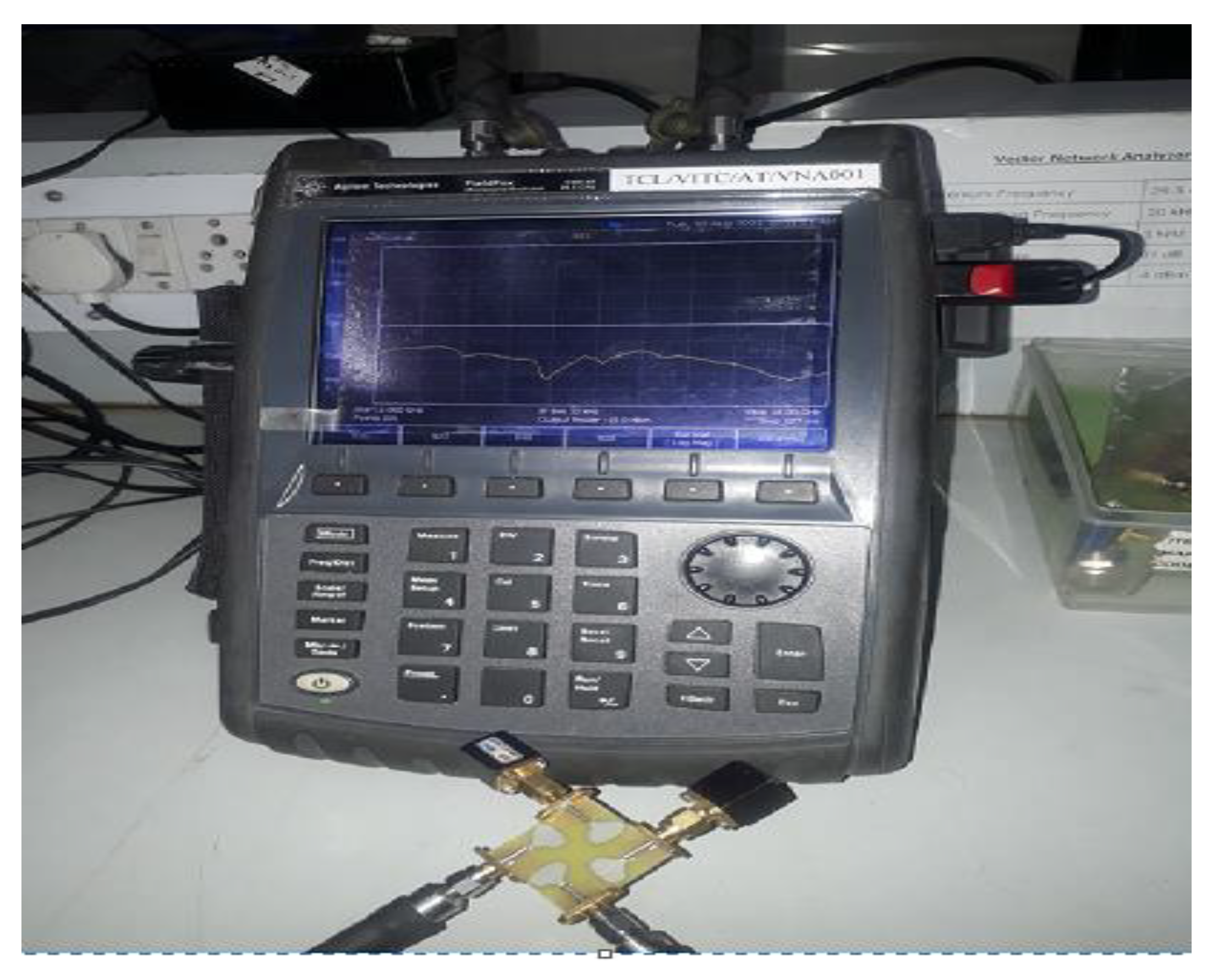
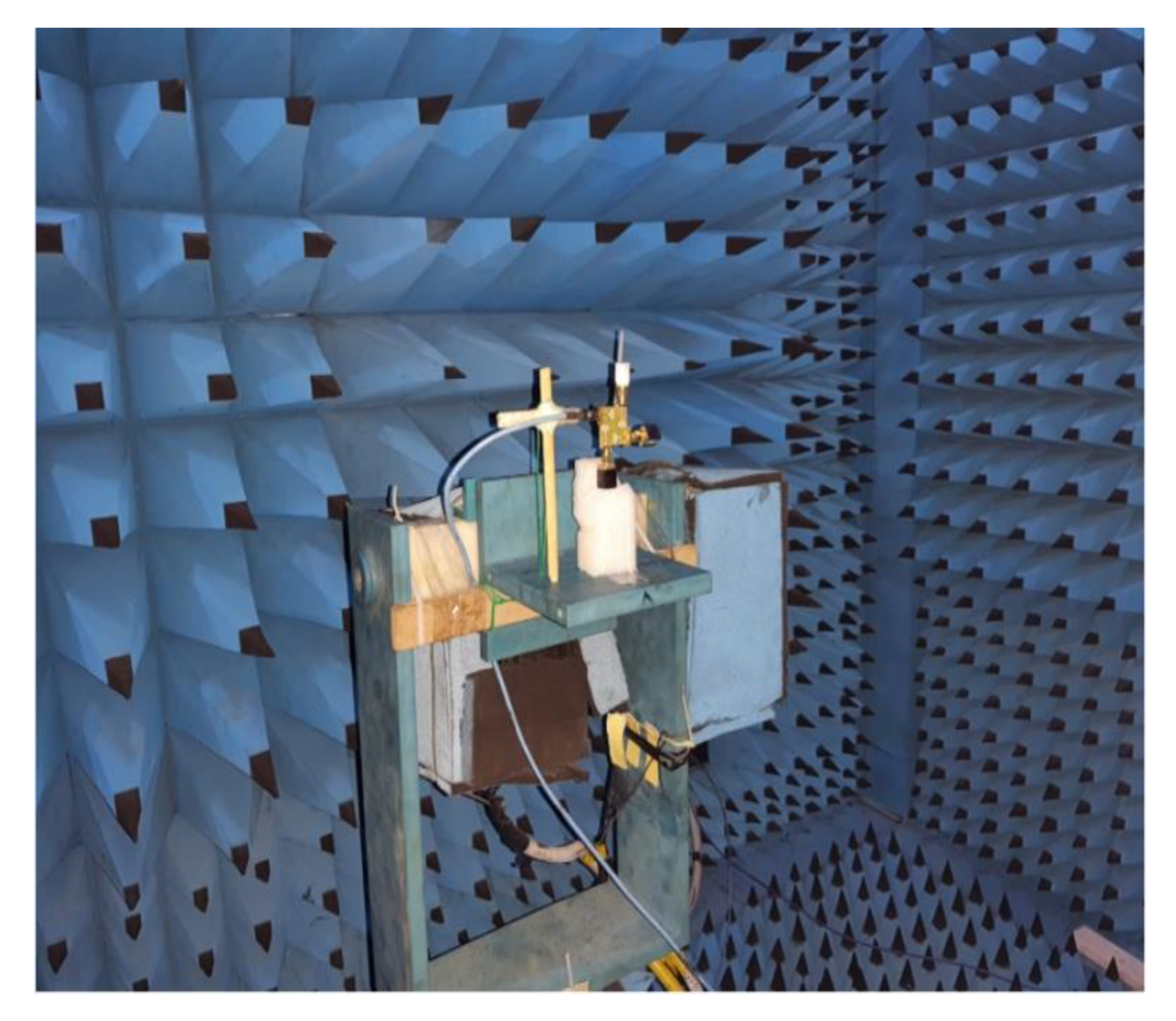
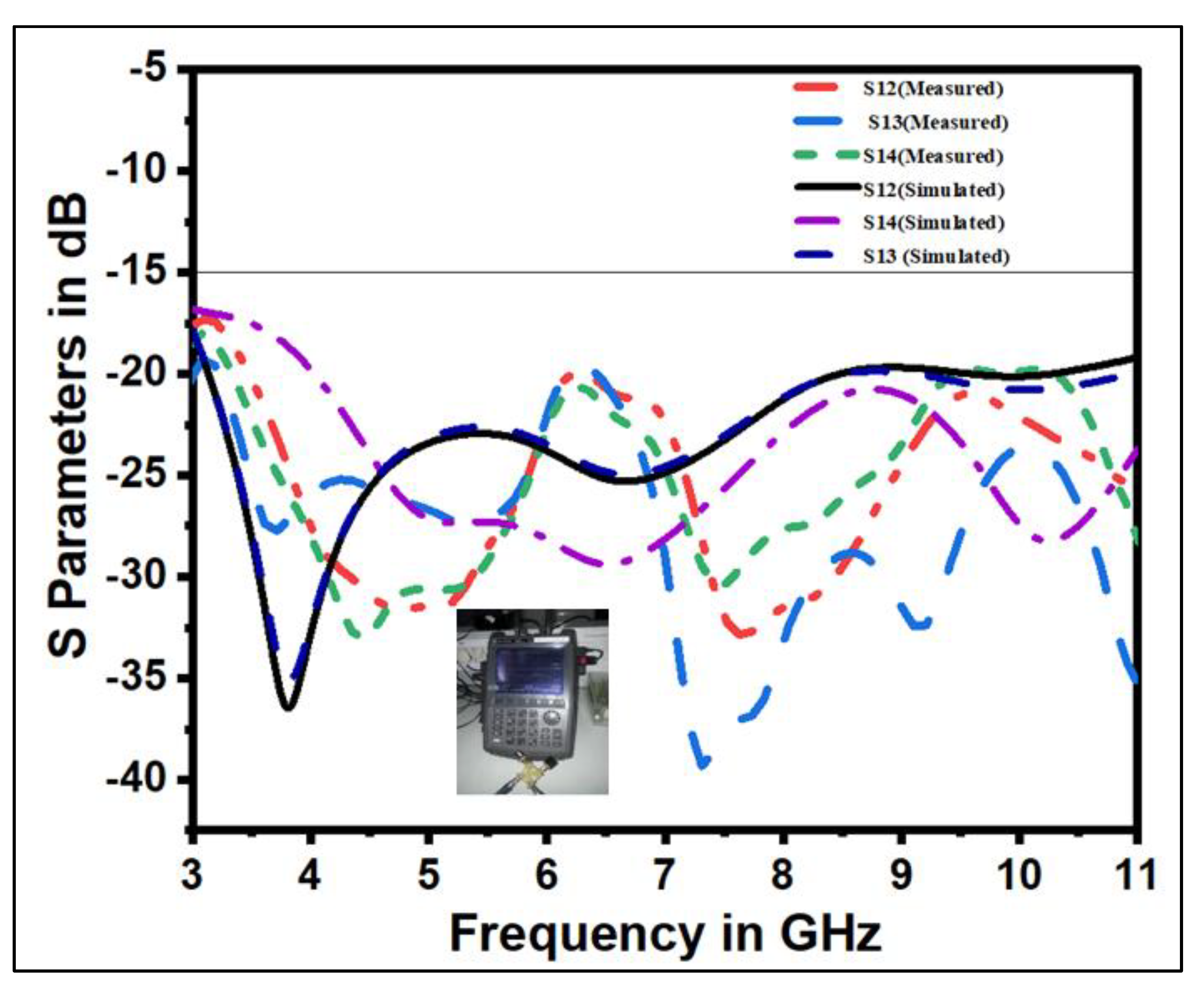
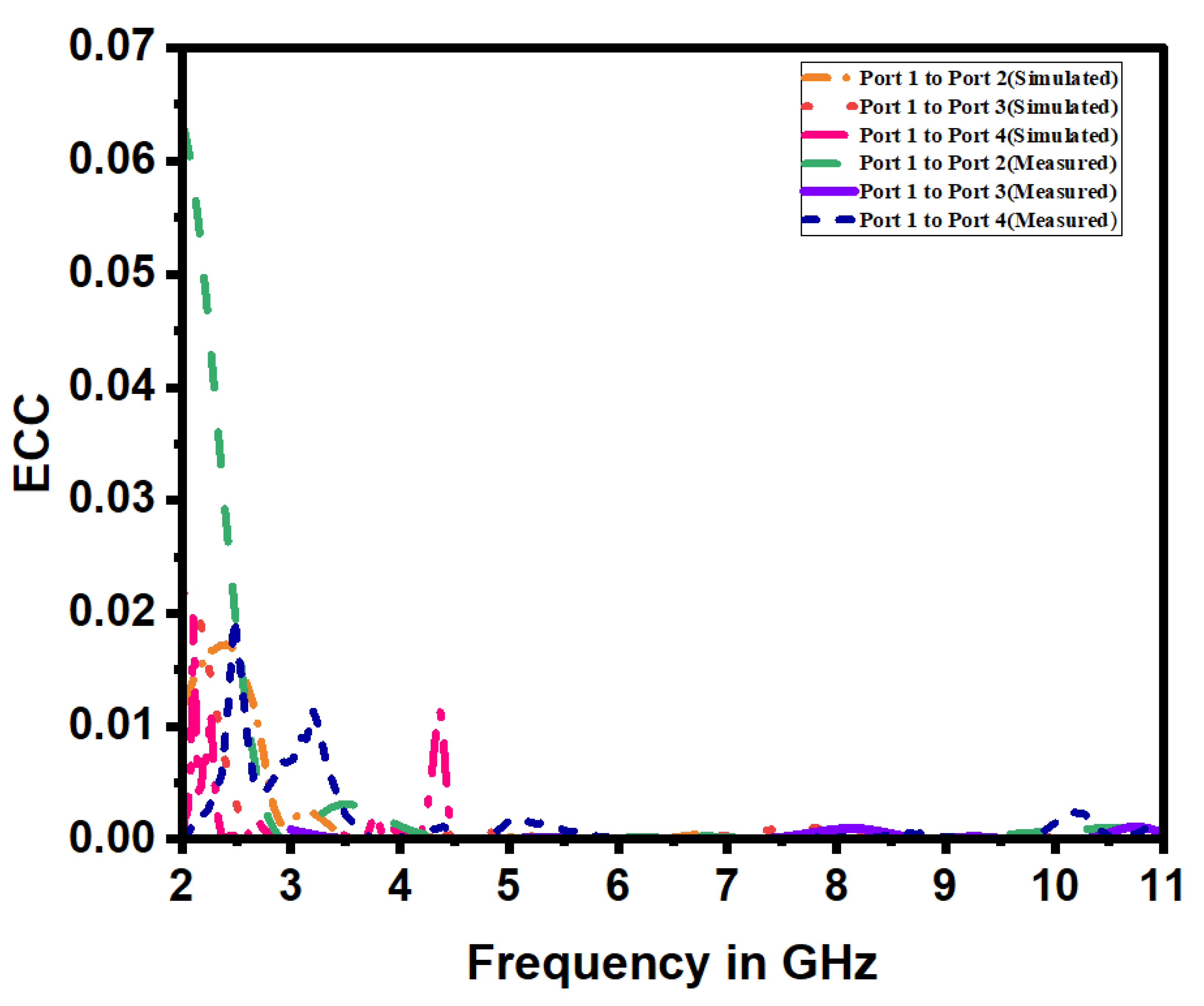
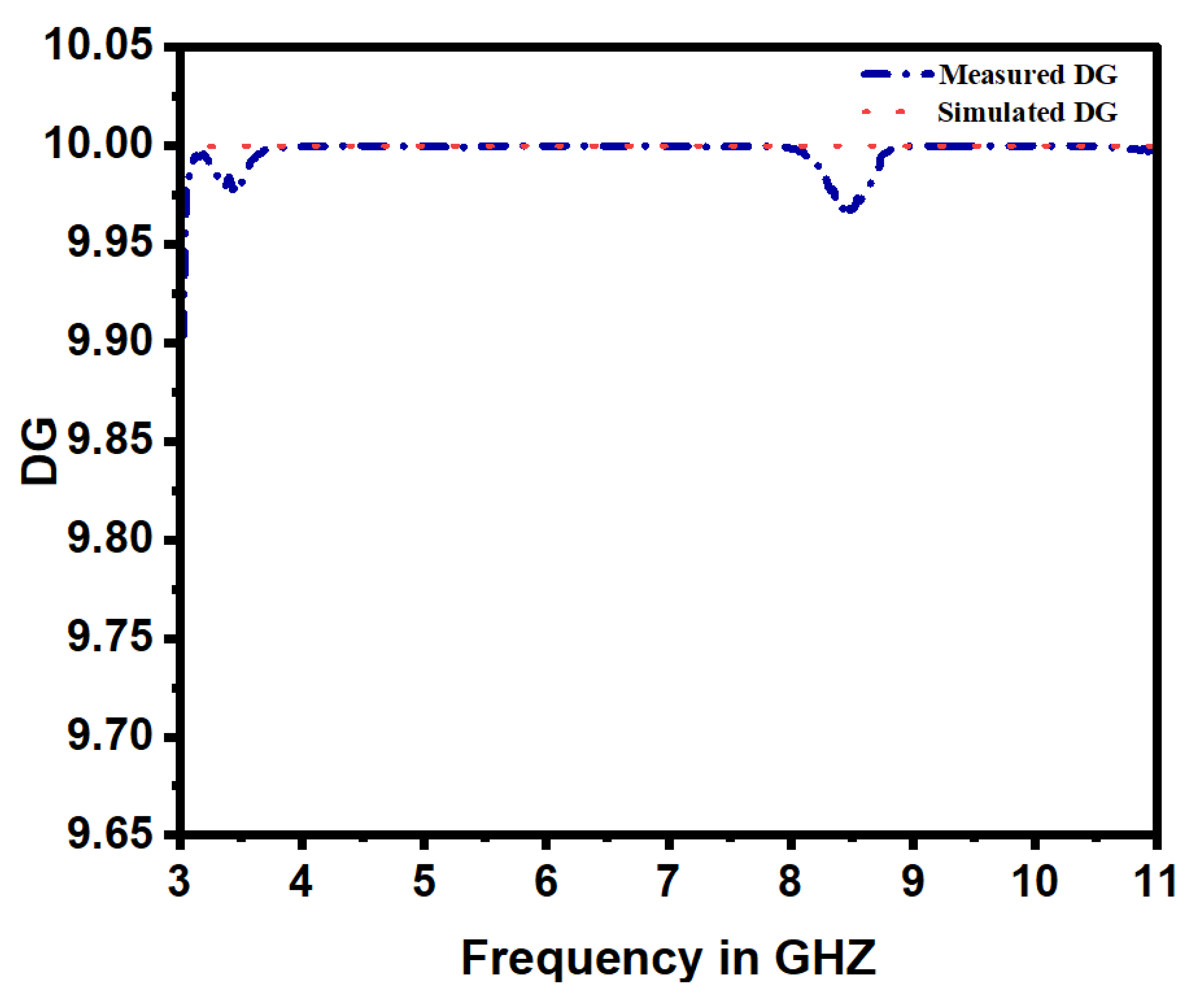

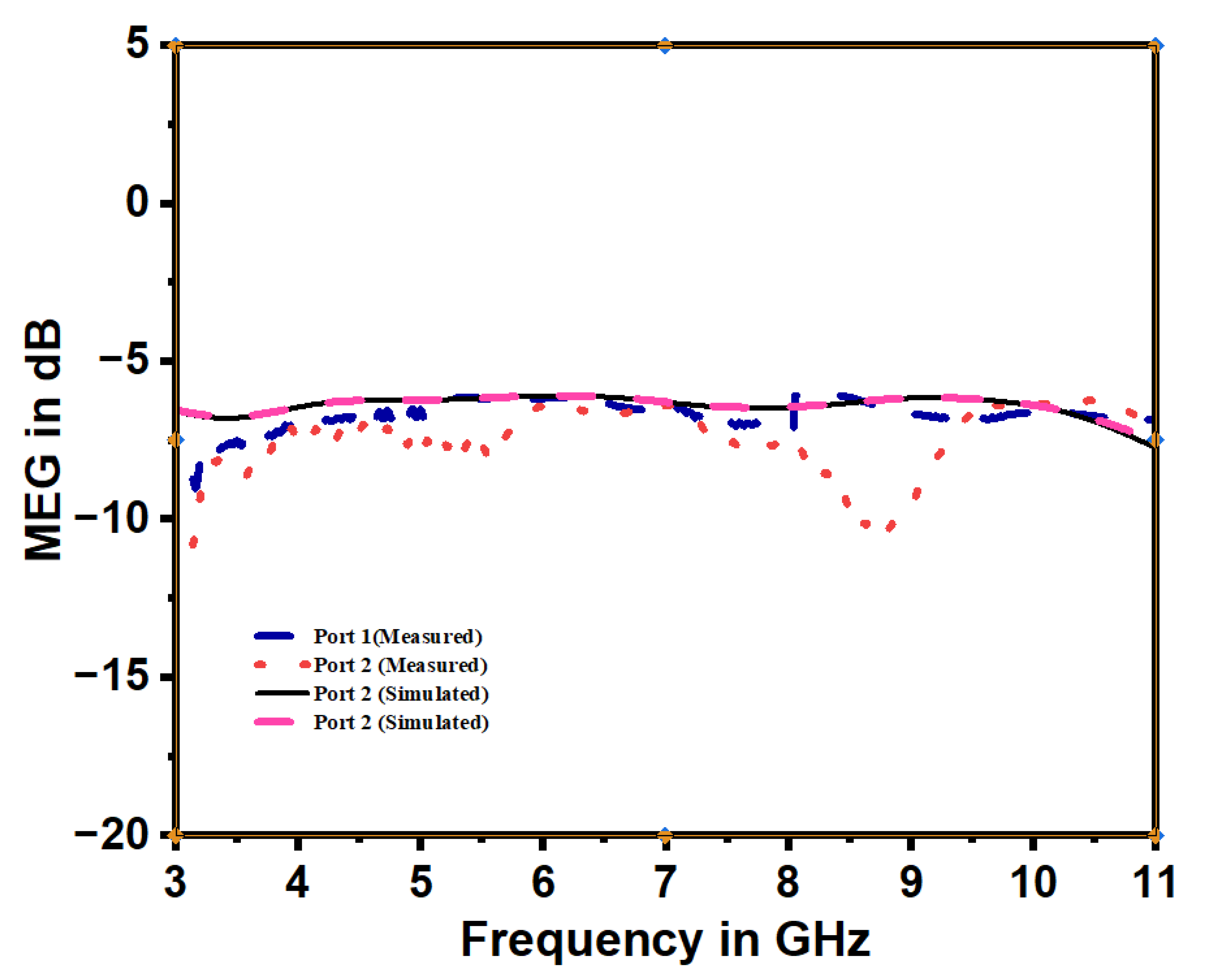
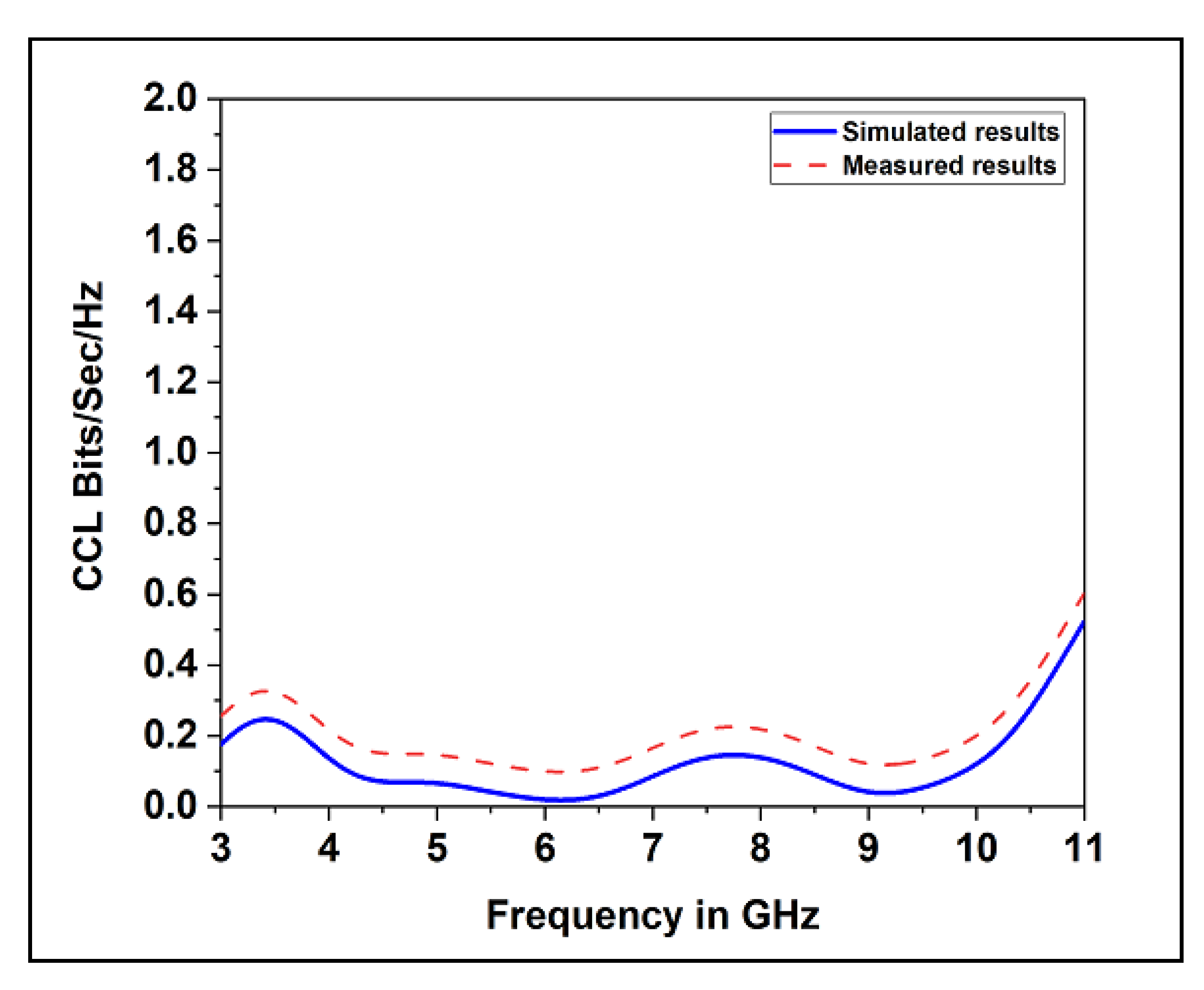
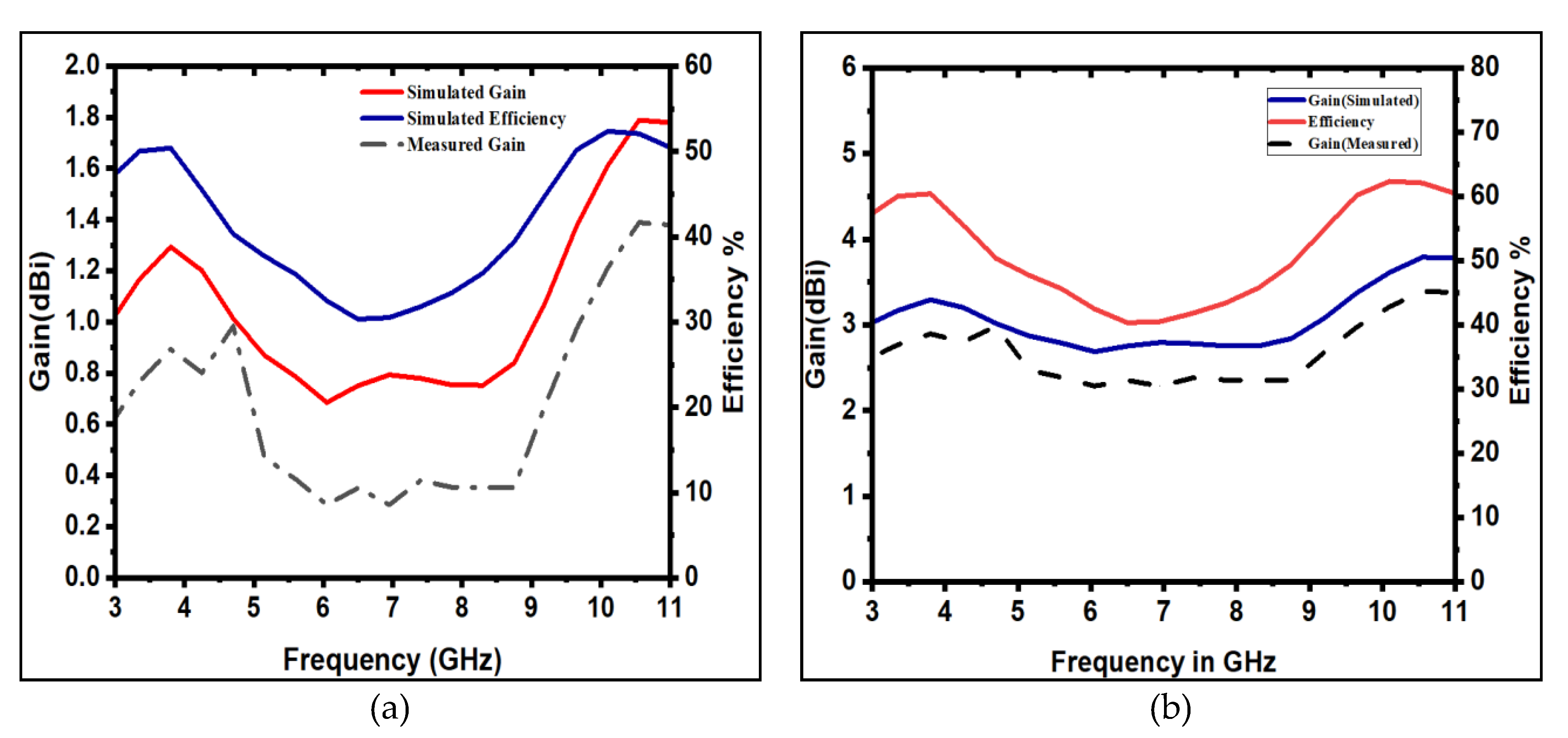


| Parameter | r1 | r2 | r3 | l1 | l2 | l3 | l4 | l5 | l6 | l7 | l8 |
| Units (mm) | 1 | 0.9 | 1.5 | 2 | 4 | 1 | 9 | 1 | 2 | 1.5 | 2.5 |
| Parameter | l9 | lg | w1 | w2 | w3 | w4 | w5 | w6 | wg | W | L |
| Units (mm) | 1.3 | 6 | 3 | 1 | 3 | 5 | 9.4 | 4.5 | 10 | 10 | 18 |
| Ref | Ports | Applied Design Method | Size (mm2) | Isolation (dB) | TARC (dB) | ECC | CCL (bps/Hz) | Gain (dBi) | GHz |
|---|---|---|---|---|---|---|---|---|---|
| [15] | 4 | AFS miniaturizing technique | 40 × 40 | >17 | - | <0.03 | - | 5 | 2.94–14 |
| [16] | 4 | Four-directional staircase-shaped structure | 39 × 39 | >22 | <−10 | <0.02 | <0.2 | 1.4–4.6 | 2.3–13.7 |
| [17] | 4 | Decoupling structure | 70 × 41 | 17 | <−9 | <0.012 | <0.4 | - | 3.1–12 |
| [18] | 2 | Coplanar-fed | 27 × 52 | ≥20 | - | - | - | - | - |
| [19] | 4 | QSCA | 40 × 40 | ≥20 | - | <0.04 | −7 | 3.85–4.67 | 2.9–12.1 |
| [20] | 2 | Fence-type decoupling structure | 35 × 50 | >25 | - | <0.004 | - | - | 3–11 |
| [22] | 4 | Rectangular slots in ground | 40 × 40 | >20 | - | - | - | - | 3–11.5 |
| [23] | 4 | Coradiator | 40 × 40 | >10 | - | - | - | - | 3–11 |
| [24] | 4 | Quasi-self-complementary | 50 × 50 | >20 | - | <0.5 | - | - | 3–12 |
| [25] | 2 | Circular coupling structure | 25 × 35 | >18 | - | <0.005 | - | - | 3.1–11 |
| [45] | 4 | Asymmetric coplanar strip-fed | 40 × 43 | 20 | −8 | <0.2 | <0.3 | - | 3.1–10.6 |
| [46] | 4 | Phase-reversed and phase-rotated antennal elements | 68 × 98 | 10 | - | <0.1 | - | - | 1.66–2.7 |
| [47] | 4 | Orthogonal, defected ground structure | 40 × 40 | >35 | - | <0.001 | - | - | 3.1–10.6 |
| Proposed | 4 | Orthogonal, tapered feed | 28 × 28 | >20 | <−10 | <0.001 | < 0.4 | 3 | 3.1–10.6 |
Publisher’s Note: MDPI stays neutral with regard to jurisdictional claims in published maps and institutional affiliations. |
© 2022 by the authors. Licensee MDPI, Basel, Switzerland. This article is an open access article distributed under the terms and conditions of the Creative Commons Attribution (CC BY) license (https://creativecommons.org/licenses/by/4.0/).
Share and Cite
Kolangiammal, S.; Balaji, L.; Mahdal, M. Design of Compact Planar Monopole UWB MIMO Antenna with Four Orthogonal Elements and Tapered Fed Configuration for Wireless Diversity Applications. Electronics 2022, 11, 3087. https://doi.org/10.3390/electronics11193087
Kolangiammal S, Balaji L, Mahdal M. Design of Compact Planar Monopole UWB MIMO Antenna with Four Orthogonal Elements and Tapered Fed Configuration for Wireless Diversity Applications. Electronics. 2022; 11(19):3087. https://doi.org/10.3390/electronics11193087
Chicago/Turabian StyleKolangiammal, Shanmugam, Loganathan Balaji, and Miroslav Mahdal. 2022. "Design of Compact Planar Monopole UWB MIMO Antenna with Four Orthogonal Elements and Tapered Fed Configuration for Wireless Diversity Applications" Electronics 11, no. 19: 3087. https://doi.org/10.3390/electronics11193087





